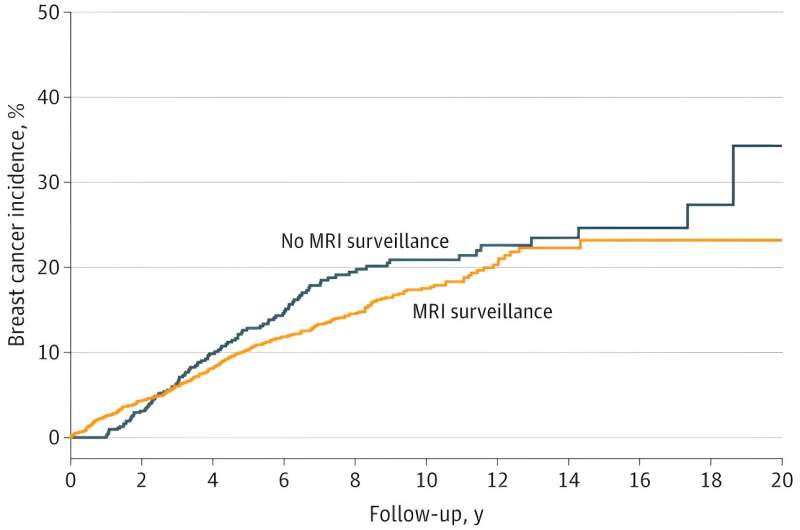This article has been reviewed according to Science X's editorial process and policies. Editors have highlighted the following attributes while ensuring the content's credibility:
fact-checked
proofread
Magnetic resonance surveillance reduces mortality in women at high risk of BRCA1 breast cancer: Study

An international study, published in JAMA Oncology, in which the Clinical Oncology group of the Sant Pau Research Institute participated, has revealed that MRI monitoring in women with mutations in the BRCA1 genes significantly reduces breast cancer mortality without the need for preventive mastectomy.
The research, which includes data from 2,488 women from 59 centers in 11 countries, highlights the reduction in mortality associated with early detection without the need for invasive surgical interventions.
Sant Pau is the only participating center in the country in this international study, highlighting the potential of non-invasive monitoring techniques as a preferred method for managing breast cancer risk in women with genetic mutations. With an average follow-up of 9.2 years, the results showed a notable decrease in the mortality rate among participants.
The results obtained open the door to evaluating the impact of MRI surveillance in women with variations in the BRCA2 gene, as well as reconsidering prevention strategies for high-risk women. This research reaffirms the importance of personalizing breast cancer prevention options, opting for less invasive methods when possible.
According to the results of an international study involving researchers from the Clinical Oncology group at the Sant Pau Research Institute, led by Dr. Teresa Ramon y Cajal, the follow-up with magnetic resonance imaging in women with mutations in the BRCA1 genes who have a high risk of developing breast cancer throughout their lives significantly reduces mortality without the need for preventive mastectomy.
The study analyzes data from women with pathogenic variants of the BRCA1 or BRCA2 genes and shows that those with BRCA1 sequence variations undergoing magnetic resonance imaging follow-up have a significantly lower breast cancer mortality rate. These results highlight the importance of early detection strategies, especially in women with a high genetic risk, and open the door to the need to evaluate the impact of this type of surveillance in women with variations in the BRCA2 gene.
The research includes data from patients from 59 different centers in 11 countries, among which Sant Pau stands out as the only center in the entire country.
A total of 2,488 women with a mean entry age of 41.2 years were included. Of these, 1,756 (70.6%) underwent at least one magnetic resonance imaging test as part of the surveillance program, while 732 (29.4%) did not undergo any magnetic resonance imaging tests. After an average follow-up of 9.2 years, 344 women (13.8%) developed breast cancer, and 35 (1.4%) died from this disease.
"These results are important because these women have a very high risk of developing breast cancer. At Sant Pau, we have followed almost 200 patients for over a decade and have been able to verify that surveillance with magnetic resonance imaging significantly reduces their mortality because we detect tumors in very early stages when treatments are very effective," explains Dr. Ramon y Cajal.
This expert adds that, "the alternative for these women at high genetic risk is to undergo a double radical mastectomy as a preventive measure. This is a very invasive technique, and it is important to remember that we are talking about individuals without any disease."
More information: Jan Lubinski et al, MRI Surveillance and Breast Cancer Mortality in Women With BRCA1 and BRCA2 Sequence Variations, JAMA Oncology (2024). DOI: 10.1001/jamaoncol.2023.6944



















